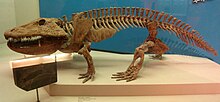| Temnospondyls | |
|---|---|

| |
| Skeleton of Eryops megacephalus in the National Museum of Natural History, Washington, D.C. | |
| Scientific classification | |
| Domain: | Eukaryota |
| Kingdom: | Animalia |
| Phylum: | Chordata |
| Clade: | Teleostomi |
| Superclass: | Tetrapoda |
| Order: | †Temnospondyli Zittel, 1888 |
| Subgroups | |
Temnospondyli (from Greek τέμνειν, temnein 'to cut' and σπόνδυλος, spondylos 'vertebra') or temnospondyls is a diverse ancient order of small to giant tetrapods—often considered primitive amphibians—that flourished worldwide during the Carboniferous, Permian and Triassic periods, with fossils being found on every continent. A few species continued into the Jurassic and Early Cretaceous periods, but all had gone extinct by the Late Cretaceous. During about 210 million years of evolutionary history, they adapted to a wide range of habitats, including freshwater, terrestrial, and even coastal marine environments. Their life history is well understood, with fossils known from the larval stage, metamorphosis and maturity. Most temnospondyls were semiaquatic, although some were almost fully terrestrial, returning to the water only to breed. These temnospondyls were some of the first vertebrates fully adapted to life on land. Although temnospondyls are amphibians, many had characteristics such as scales and large armour-like bony plates (osteoderms) that generally distinguish them from the modern soft-bodied lissamphibians (frogs and toads, newts, salamanders and caecilians).
Temnospondyls have been known since the early 19th century, and were initially thought to be reptiles. They were described at various times as batrachians, stegocephalians and labyrinthodonts, although these names are now rarely used. Animals now grouped in Temnospondyli were spread out among several amphibian groups until the early 20th century, when they were found to belong to a distinct taxon based on the structure of their vertebrae. Temnospondyli means "cut vertebrae", as each vertebra is divided into several parts (intercentrum, paired pleurocentra, neural arch), although this occurs widely among other early tetrapods.
Experts disagree over whether temnospondyls were ancestral to modern amphibians (frogs, salamanders and caecilians), or whether the whole group died out without leaving any descendants. Different hypotheses have placed modern amphibians as the descendants of temnospondyls, as descendants of another group of early tetrapods called lepospondyls, or even as descendants of both groups (with caecilians evolving from lepospondyls and frogs and salamanders evolving from temnospondyls). There is further disagreement about a temnospondyl origin of lissamphibians related to whether the modern groups arose from only one group (dissorophoids) or from two different groups (dissorophoids and stereospondyls). The majority of studies place a group of temnospondyls called amphibamiforms as the closest relatives of modern amphibians. Similarities in teeth, skulls and hearing structures link the two groups. Whether temnospondyls are considered part of the tetrapod crown or stem thus depends on their inferred relationship to lissamphibians.